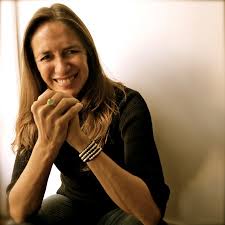YogaCityNYC ~ interview with Anneke Lucas of Liberation Prison Yoga
Liberation Prison Yoga founder and child sex trafficking survivor Anneke Lucas is breaking cycles of abuse with a vengeance steeped in compassion, as she pays it forward in New York prisons. With eighteen classes already in operation, she is now spearheading an Indiegogo campaign to double their programs and pay for other expenses.
“Wounded people can best be healed by other wounded people” is Anneke’s mantra, and her mission is to continue the ripple effect of yoga benefits that she herself has experienced when this message is put into action. She is helping not only an often forgotten and powerless portion of humanity that needs to know someone cares about them, but also a growing group of yoga instructors who crave a deeper service than the typical class provides.
YogaCityNYC’s Sharon Watts sat down with Anneke to learn more.
Sharon Watts: The early trauma of being forced at age five into a child sex trafficking ring by your own mother has lead to your involvement with yoga. How does this healing bridge connect to today?
Anneke Lucas: I lived with an enormous guilt complex my whole life, which kept me from stepping into my own power. I know the inner voice of self-castigation very well. I know now to recognize it as an abuser’s voice. My abusers had to blame me to justify what they did. Society blames prisoners, and in that blame, justify the horrors of our current situation. By teaching prisoners to recognize their goodness, I’ve learned to listen to myself and put it into practice. I’m still working on it. I also tell my students that they are advanced yogis – because they are. We are able to get to the stillness within amid chaos.
SW: Yoga for the incarcerated is on the rise. How did this evolve?
AL: Yoga has become widely recognized as beneficial for health and recovery, so when someone wants to start a yoga program in prison, the authorities don’t need to be convinced. Also, so many yoga teachers have been healed by yoga, that serving traumatized populations reconnects teachers with the purpose of why they wanted to teach in the first place.
SW: What are some misconceptions we might have about prisoners?
AL: One is that prisoners are bad people who don’t deserve anything good. It’s a narrow-minded view that leaves out the question: “How do you want a prisoner to be when he or she returns to society?” I don’t really find people in prison any worse than on the outside. There are many people with mental health issues, who need care. In the end, criminals all have mental health issues, including the successful psychopaths that run the world.
SW: Beyond good intentions, what qualities does a yoga teacher need to teach in prison?
AL: Despite being very warm, empathic people with the best intentions, yoga teachers who want to serve in prison purely out of political conviction are often not that well-suited, because the prisoners can’t necessarily relate to them. In my experience, it is the wounded healers who are able to connect and make a difference. They understand what is needed–compassion more than expertise.
SW: What can a teacher expect from Liberation Prison Yoga to prepare for this service?
AL: Teaching inside is very different from teaching a regular class. The physical practice may be the same, but we focus on down-to-earth kindness reflected in language (no commands), and a structure to optimize safety and predictability. Ideally a volunteer will have several workshops with me before they enter.
I’m developing a 50-hour trauma conscious training for RYT-200 certified teachers. But training isn’t enough, and it’s not always practical to wait until after teachers have completed 50 training hours. Mostly I look for people who are able to serve as yoga therapists: teachers working from this new paradigm where the focus is on the student’s self empowerment rather than on the teacher’s skill. I go in with and guide new teachers until they feel comfortable taking over their classes. Our primary purpose is to connect–in a safe way.
SW: You are a motivator and mentor for many women in prison who also have survived sex trafficking. What motivates you?
AL: Some women have never shared until now, in these groups I lead. My own motivation is my daughter Charlotte, who is fourteen. I had to step up to be a mother, and that caused me to go deeper into my own healing, my own liberation. Helping others to heal, breaking the cycle of abuse–I consider this a life calling.
SW: What are some results, and future goals?
AL: I personally see the results–my students leave jail and live a better life because they felt heard and understood in their yoga class. They use yoga and mindfulness tools to keep coming back to a positive place, bravely facing the challenges of re-entering society as third-class citizens. They return to their communities as leaders, paving the way for a new paradigm of love–turning authority and power on its head by recognizing that our shared humanity is the great equalizer, and we all need help.
With this immediate fundraising effort, we’d like to reach our stretch goal of $100,000. Beyond serving New York, we have developed a model that can be replicated and expanded, and are in negotiation with yoga teachers all over the world, ready to go inside the prisons to bring healing from within.
I currently donate over 40 hours a week to this project and have not yet made a dime. My savings are dwindling, and I am a single mom. I want to continue what I am doing.
April 2015

